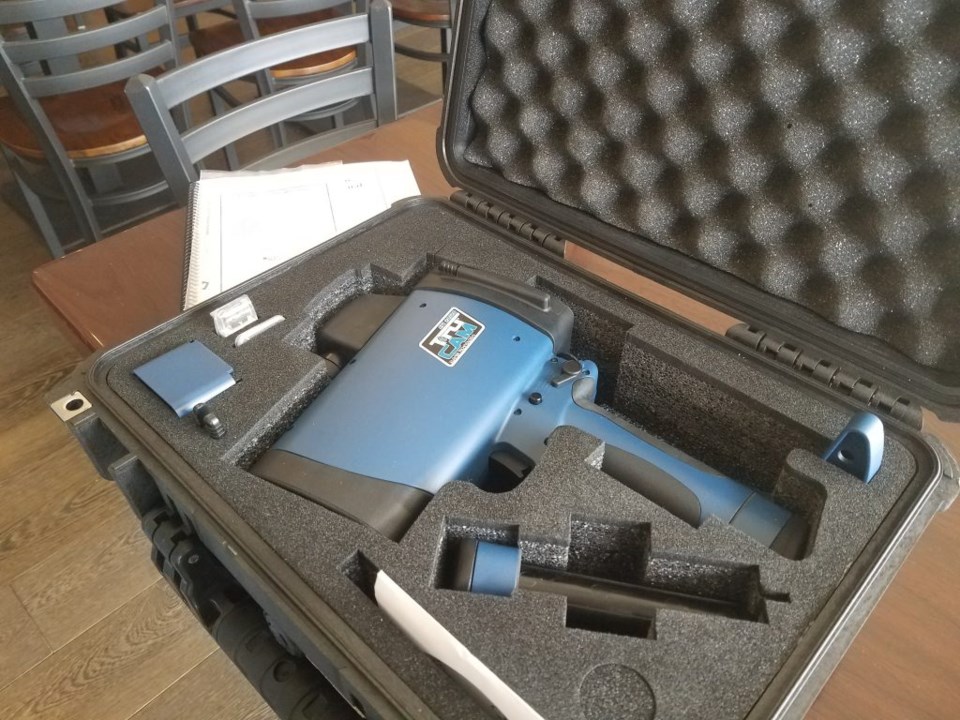This content was originally published by the Longmont Observer and is licensed under a Creative Commons license.
The Longmont Police Department was awarded a $6,000 TruCAM laser speed-measuring and video-recording radar gun from the Colorado Department of Transportation (CDOT) for their efforts during the Click-It or Ticket campaign this year.
In 2017, the Highway Safety Office (HSO) began to award law enforcement, specifically traffic safety, for outstanding performance in high visibility occupant protection enforcement during Click It or Ticket, and Thornton Police received this award in 2017. The decision process comes from the HSO who uses a formula which analyzes the amount of traffic citations in relation to the enforcement funding awarded to each agency.
The TruCAM is a laser speed-measuring device that has a video camera incorporated into the device that can also capture a one second video clip of the violation as it occurs. The clip is then recorded onto a standard memory card that can be used for any other types of cameras.
“It's newer, in that the laser or lidar has been around for quite a while. Whereas the camera incorporation, we have another one of these units, that we've had for probably six years. At the time that we got it, it was new technology,” said Colby Julian, Longmont Police Department, Master Police Officer, Traffic Unit. “So, it's been around for a little while, but laser, or lidar, technology has been around for quite a while. The incorporation of the video camera into the device is newer but not super new.”
The Traffic Unit usually reserves the use of the TruCAM device for saturation days, which are days that are specifically sets aside to target speeding violations, so normal use of the TruCAM is when they involve a significant number violations in a day. Now that they have two of them, it will be up to the traffic supervisor whether or not the devices will be put into regular rotation for an officer.
https://www.youtube.com/watch?v=sTYuh92Q2Bw&feature=youtu.be
“I think it helps corroborate an officer's testimony, if somebody that receives a ticket, if they're going to contest the charge, it helps to have the video clip of the violation as it occurs, the vehicle, depending on the clarity of the video, possibly the license plate,” Julian said. “The few times that I've been in court where somebody has contested a charge where we've used the TruCAM, once they see the video up on the screen, they kinda change their mind as to what their plea is gonna be.”
The camera can only see to the extent that is visible to the naked eye, so it is difficult to see into the interior of the vehicle. The TruCAM is usually not that accurate in distinguishing if people are wearing seat belts, but it can certainly distinguish the car, license plate, and speed of the car.
“That's what we do for our Click It or Ticket enforcement because a seat belt violation is considered a secondary violation. We can't pull somebody over just for not wearing their seat belt, unless they're a juvenile. We have to have a primary violation in order to have probable cause to make contact with them,” Julian said.
They use speed as the primary offense and will have the laser operator, the officer, stand out on a sidewalk with the TruCAM. When they get a speeding violation of a vehicle that is headed towards them, and as the vehicle approaches, they make a visual observation of the occupant inside the car to determine whether or not occupants in the car are wearing their seat belts. Then they radio to a contact officer who will then pull the car over and make contact with the driver and eventually issue the ticket.

“It typically works better in the day just because of the ambient light that is needed for the camera to fire an image. Just like your camera would need a flash or light at night in order to capture an image. So, we don't typically use it at night,” Julian said. “We ticket people from underage drivers that don't have a driver's license at all, to people in their eighties and nineties.”
According to CDOT, the HSO vision is that law enforcement agencies will continue with sustained enforcement of occupant protection laws throughout the year, not only during established Click It or Ticket enforcement periods. This equipment will also enable Longmont traffic officers to enforce traffic laws regarding speeding, following too closely, and other hazardous violations that lead to traffic crashes.


